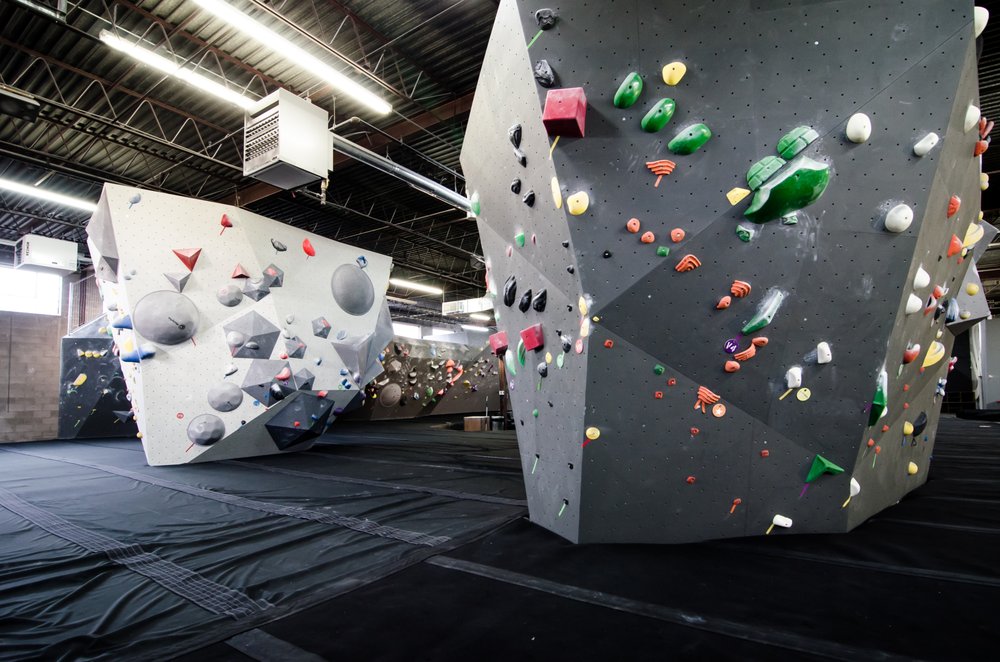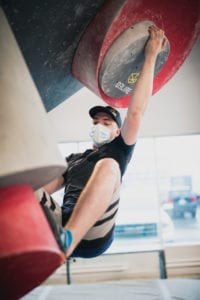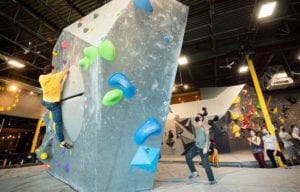Climbing Gyms: Innovation in Recreation
Climbing gyms have always been community centres. We spoke with Délire and Bloc Shop about community and reopening during the pandemic.

The new shapes and skate-style technique of competition movement are examples of how far climbing has come. In Canada, the route setting is defined by large shapes, while the style built around coordination and balance. Competition and indoor climbing have allowed for some climbers to become entrepreneurs with businesses based in creativity.
Quebec is at the heart of Canada’s most innovative climbing communities.
From Flathold’s pioneering approach to fibreglass, to Dimension’s mammoth-sized volumes, Quebec’s communities are constantly innovating. Their creations are a function of the communities that built them. Their work has produced the most cutting-edge climbing gyms in the entire country.
Climbing gyms can be many things. To their communities, they function as interactive canvases created and re-created for the climbers that use them.

Délire
Délire lends decades of experience to its gyms. Originally hold builders, and then wall builders, Délire has seen the many sides of indoor climbing. Vincent Legare has been with Délire since the beginning. To him, it is Délire’s climbers that make his gym strong.
He said, “I think we are Délire. We are climbers. We have been travelling around climbing, hitching rides, and living in vans for the past 25 years. It is what we are still doing. We are surrounded by people that are passionate like we are. All the staff members of the gym are passionate climbers and they always go out. Even the team that is building walls are passionate climbers.”
This passion for climbing is what inspired Jeff and Lisa to create Délire.
Legare said, “We built the first gym in 2008. It was one of the first gyms of the new wave. It took us a good five years to get used to running a business and running a climbing gym. At first the crowd was really small.” With time, it would grow, and by 2014, they would be looking to expand.
Around that time, they were in conversation with Montreal’s Fred Charron. “He had been talking about the idea of opening a bouldering gym.” When it was successful, “We followed with our own a year later.”
At the time, a bouldering-only facility was a bold move for climbing gyms. Though it has become more common in recent years, the opening of a bouldering-only gym took guts. It took listening to their member-base. Legare said, “We thought about our needs as climbers. We went through the team and asked them what they needed to train, what they needed to climb, what they liked to climb. That is just part of the process. What is the customer going to like? What is the trend right now? We need to have a good gym if we are going to love going climbing every single night.”
For climbers, this is essential. “If you don’t know what to do on a Tuesday night, just go to the gym, all of your friends are going to be there and you can have a big session. It’s a weird time to say that it is a good place to go socializing, but it is. It is a place to meet your friends.”
Though climbing gyms still do manage to serve as community centres, the pandemic has definitely changed the way people interact with a facility. Legare said, “We had to reduce the capacity of the gym. That is the big difference that you feel when you come in on a Friday night. It is good for the climbing experience, but for the socializing part, it is not as fun.”
With that said, the community is excited to be back in the gym. According to Legare, “All of the members and staff were thrilled to go back to climbing. We didn’t lose any staff in the three months that we were closed, so when we reopened, every staff was there. I think they like their experience working with us, so they were still supporting us. Many members didn’t freeze their accounts when we were closed and continued paying their membership every month.”
“They definitely wanted to help us through the pandemic. They don’t want their gym to close, they want it open. They want to climb. They need to climb.”
This is why they work to remain open. Legare continued, “I met a member yesterday. He told me, ‘If you close another time, we’re going to be there. Don’t freeze my account, I’m going to pay, I don’t mind.’” Legare smiled, “That is the idea behind a community.”
In exchange, Legare said, “I want to keep every person climbing. I think most of our climbers are as passionate about climbing as I am. They want that gym open. They want it to be as it was before the pandemic. They want the rotation of the boulders and the routes. We have to do what we can for them.”
Even for those that have never been climbing, Legare noted that now might not be a bad time to learn. He laughed, “It is always a good time to learn to climb. It is still a fun sport. With the reduced capacity in the gym, it is actually less intimidating to go, it is easier to make friends, and the masks you have to wear anyway, so you get used to it.”
“It is always a good time to get involved with a new sport and workout activity. It’s going to be fun. I am always impressed by the challenging routes that our gyms are offering.”
Legare, took a moment to describe the routesetting specifically. He admitted that Délire’s setting can be tough, but that is a good thing. “To be interested in climbing, it has to be challenging, and that’s what we offer.” The technical, clean lines of Délire’s setting is but one side of why so many love Délire gyms.

Though the pandemic has been difficult for Délire, it is made easier by the support of the facilities’ amazing staff. Legare said, “They are so passionate. If you get into the gym and start talking climbing with the staff, you’ll see it right away that they love it. That is part of our uniqueness.”
One such staff member is Florence Grondin-Robitaille, from Délire’s roped location. She began working at Délire over four years ago, and literally applied to the company because she, “wanted a job that (she) wanted to work. I wanted to go climb outside and I thought that this would be a good way to learn to.”
Since that time, Grondin has experienced many of the things climbing has to offer. She reflected on what she loved about the sport and found it to be the confluence of community and adventure.
She said, “I think what I always liked about the sport is that there are always new and different things to do: ice climbing, trad climbing, bouldering, multi-pitch. It gives you a different opportunity to go travel. You go to places in a country that you wouldn’t go if you were not climbing. It is really different, and since you are always against yourself, you can always get better. I like the vibe of the people, that is something I liked at the beginning. They are welcoming. The fact that most of the climbers want to help their community is cool.”
It is for that reason that gym owners have put so much time into supporting their communities. Upon returning to the gym Grondin said, “I think it is like seeing family again. It’s great to see everybody again and to climb together. I think we were all pretty excited about that. When we were in the pandemic at first, my boss, would keep us updated about what was going on. They would make a video every week that would tell us how things were going and what they were changing to keep us ready for when the gym would open again.”
“As such, I think we were aware of what was happening. It was a bit stressful for some of the staff, but I knew that they would do everything that the government asked because they wanted to be open and get people to come climb again. I think my boss did everything to make us feel safe.”
Bloc Shop
Working to keep people safe during pandemic is not easy work. Bloc Shop’s Cloé Legault mentioned that they have had to make a great many changes to their locations just to ensure social distancing. Legault said, “We removed all benches, chalk buckets, stretching areas, modified our water fountains for bottles only and reorganized our fitness areas to ensure social distancing. Our front desk is now surrounded by plexiglass and we installed floor markers at every two metres along our pads. We made our best effort to give our clients a clean and safe environment to play with.”
In true Bloc Shop fashion, however, Legault mentioned that the Montreal-based gym spent time working to better their facilities as well, “We definitely took advantage of the gym closure to do some major cleaning and renovations. All the climbing walls and pads were thoroughly cleaned and both gyms were completely reset.”
Much like Délire, Bloc Shop’s staff were excited to return to work following the end of lockdown, “In general, our staff has been awesome and eager to help us work through these strange times. We saw some reticence in some individuals at first due to all the new procedures but the whole team quickly adapted. With limited numbers of clients, masks and plexiglass, the vibe for our staff has significantly changed. This said, our team is aware of our new reality and are willing to adjust to the new procedures and regulations.”
“So far, the feedback has been extremely positive. We have had very good comments about our system and how we reorganized our facilities and adapted to this new reality. In general, people are just grateful to finally have the chance to move, get back in shape and get their fitness fix.”
“The greatest challenge would be not knowing and having no control over what happens next. Will things go back to normal in a few months or will we see the anticipated second wave? What will be the next government’s last-minute decision we will have to adapt to?”
“This obliviousness creates many other challenges such as consistently communicating new procedures to our staff and community. Adapting and managing our booking system. Last minute renovations and re-organisations of our facilities.”
As with Délire, Bloc Shop has had to manage the challenge of covering costs. Legault said, “The tricky thing seems to be finding what costs we should worry about. We can’t worry about everything, so we need to focus on the important costs and stop wasting time with nonsignificant spending. It’s easier said than done. Time will tell how long it will take to regain balance and confidence.”
Fortunately, to help offset some of the damage cause by the pandemic, Bloc Shop felt the support of some of the members in its community. Continuing their memberships over the course of lockdown, they sought to give back to those members as best as they could.
Legault said, “We called all of our members personally, starting with those who supported us financially during the confinement. We asked them how they were, we listened to them, we discussed the extent of the situation for Bloc Shop if they had questions and above all, we told them we missed them.”
“The first two opening days were reserved for members who supported us during the confinement. We wanted to thank them for their generosity and allow them first access to the gym. It felt good to be able to thank people in person and tell them how their gesture was important for the company and how much we were touched by it.”



